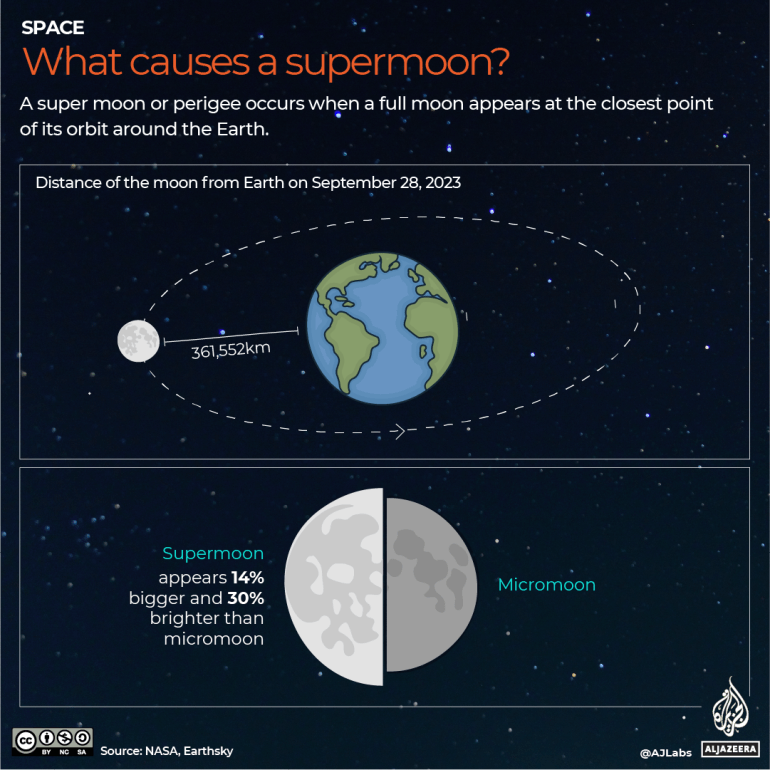On the night of September 17, the Earth, Sun and Moon will be in a line, creating three celestial events.
In many places, depending on the time zone, people have the opportunity to experience a full moon, a supermoon and a lunar eclipse when the full moon rises.
Here’s what you need to know about these events:
First things first: What is a full moon?
According to NASA, a full moon is the moment when the moon is exactly 180 degrees opposite the sun. During this time, the sun illuminates the Earth’s satellite almost completely.
According to NASA, this month’s full moon will peak on Tuesday, September 17, at 10:35 p.m. EDT (or 2:35 a.m. GMT on Wednesday, September 18).
Full moons generally rise at sunset and set at sunrise. The lunar cycle consists of eight phases and repeats every 29.5 days.

What is a partial lunar eclipse?
A partial lunar eclipse is the time when part of the full moon is obscured by the Earth’s shadow.
The shadow expands and then recedes, but never reaches the phase of totality. In contrast, during a total lunar eclipse, the full shadow of the Earth covers the Moon completely.
The moon will begin moving into Earth’s penumbra at 8:41 p.m. EDT on Tuesday (12:41 a.m. GMT on Wednesday). The initial dimming may be slight until the top of the moon moves into full shadow at 10:13 p.m. EDT on Tuesday (2:13 a.m. GMT on Wednesday).
The eclipse will reach its peak at 10:44 p.m. EDT on Tuesday (2:44 a.m. GMT on Wednesday), when only the top eight percent of the moon will be in complete shadow.
The Moon will exit the full shadow at 11:16 p.m. EDT (3:16 a.m. GMT) and will completely exit the partial shadow at 12:47 a.m. EDT (4:47 a.m. GMT) Wednesday morning.

What is a supermoon?
This moon will also be a supermoon.
A supermoon is an astronomical phenomenon in which the full moon appears larger and brighter than usual. It occurs when the full moon occurs exactly when it is closest to Earth in its orbit.
According to NASA, the term “supermoon” was coined in 1979 by astrologer Richard Nolle to describe a full moon that occurs when the moon is “within 90 percent of its closest position to Earth.”
Essentially, the Earth, Moon, and Sun are all in a line at this point. At the other end of the spectrum of lunar visibility is the micromoon – when the full moon looks particularly small and faint because it coincides with the point in the moon’s orbit where it is farthest from Earth.

Is this also a harvest moon?
The full moon is the full moon closest to the autumnal equinox in the Northern Hemisphere, which this year occurs on September 22 at 12:43 GMT.
So yes, this is also a harvest moon.
According to the Farmer’s Almanac, “This full moon rises at nearly the same time several evenings in a row—around sunset.” This results in plenty of bright moonlight being seen in the early evening.

This phenomenon has traditionally helped farmers harvest their summer-grown crops by giving them several extra evenings of moonlight, hence it is also called the Harvest Moon.
The full moon has an orange-red hue. It appears larger and brighter than other full moons due to an optical illusion that occurs when the moon is close to the horizon.
The color of the moon is caused by the moonlight being filtered through more of the Earth’s atmospheric particles than when the moon is above us.

So how will the event on Tuesday develop overall?
- The full moon will peak at 10:35 p.m. EDT on Tuesday (2:35 a.m. GMT on Wednesday), when it will also be at its brightest.
- The peak of the eclipse will be reached at 10:44 p.m. EDT (2:44 a.m. GMT).
The total duration of the partial lunar eclipse is four hours and six minutes.
For observers in the Eastern Time Zone of the United States, the eclipse will reach its darkest phase on September 17 at around 10:44 p.m. EDT.
In Europe and Africa, the eclipse will be visible in the early hours of September 18. In the United Kingdom, the eclipse will be most clearly visible on September 18 at approximately 3:44am CET.
People in the Gulf region will not be able to witness the peak of the eclipse, but they will be able to see the moment when the partial solar eclipse begins at 5:15 a.m. local time on Wednesday.
On the map below you can see in which countries the peak of the solar eclipse will be visible on Tuesday.

How can you observe the lunar eclipse and the full moon?
If you are in the right time zone, a casual stargazer can observe the lunar eclipse, although it is better to stay in darker locations.
NASA also recommends using binoculars “with at least 7x magnification” and notes that “10x or 15x magnification provides more detail; you may need a tripod to stabilize the binoculars.”

